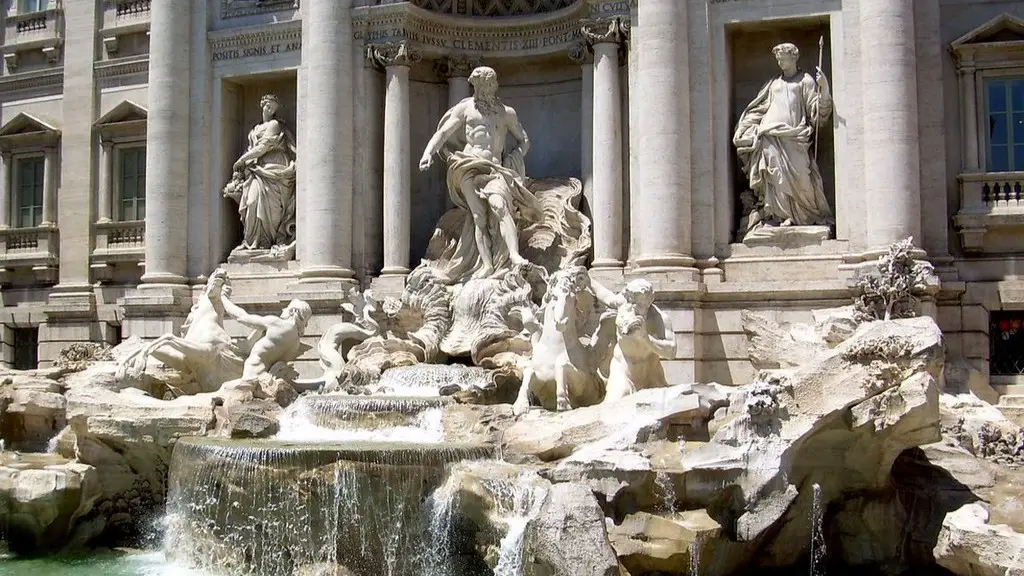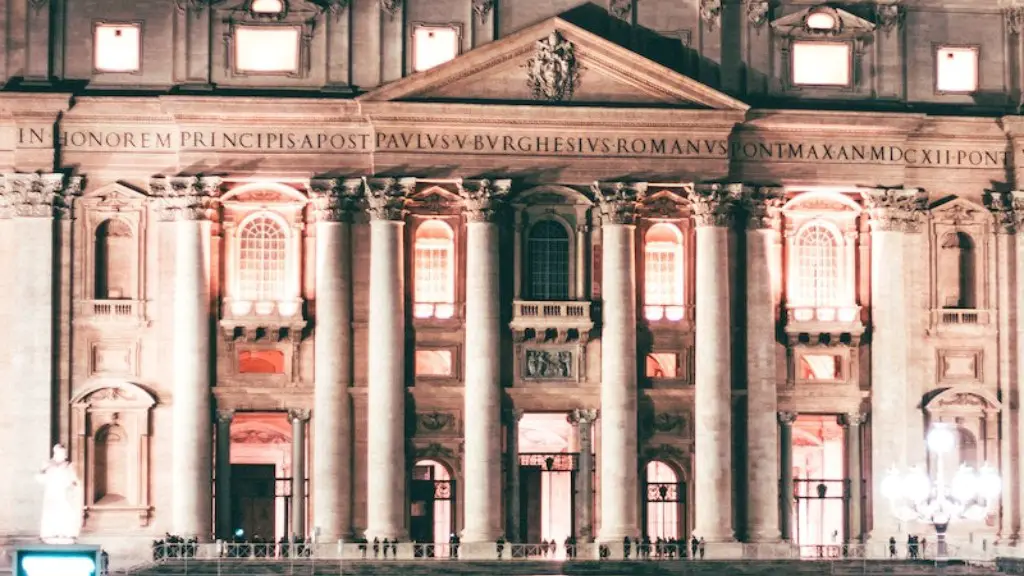Volcanic Eruption of Mount Vesuvius
The destruction of the ancient Roman settlement of Pompeii is an infamous example of the destruction caused by natural disaster – in this case, a volcanic eruption from Mount Vesuvius. The 79 AD event left a lasting mark on the history of Roman civilization, leading to a game-changing event that would ultimately be remembered in both the Roman and modern worlds.
The eruption of Mount Vesuvius was one of the most powerful in the history of Italy. The force of the explosion created massive pyroclastic flows – fast-moving currents of hot gas, vapors, and volcanic matter – that engulfed the city of Pompeii and its surrounding areas. Within the span of a few days, the effects of the eruption reached across an area of 4,000 square kilometers, covering the now-famous city with a thick coating of volcanic ash.
Experts suggest that although Mount Vesuvius had been erupting for many years before the 79 AD event, it was the power and magnitude of that one particular eruption that wiped out the city of Pompeii. The ash from the eruption was so dense and damaging that it caused the walls and buildings of the city to collapse and disintegrate. This led to the deaths of over 5,000 people, a number that was unfortunately much higher than any other historical volcanic eruption of the time.
Many of the remains found on the site of Pompeii were preserved by the thick layer of ash. The fact that the archaeological discoveries have withstood time is due to the intense temperatures of the pyroclastic flows that engulfed the city. It is believed that these remains, which include not only human skeletons but also everyday items such as kitchen utensils, coins, wine jars, and furniture, are a direct consequence of the extreme heat and force of the eruption.
The devastation caused by the eruption was so great that it had a direct impact on the health and social systems of Rome. It led to significant political and economic changes in the city-state, as well as a decline in the availability of goods and services. It also led to an increase in taxation and a decline in the Roman economy.
So severe was the effect of the disaster that it was remembered in both Roman and modern history alike. Scholars note that the event was mentioned in various sources, confirming that its memory did not fade away with time. While the event of 79 AD is thought to have caused an overall decline in Roman culture and society, it is also credited with being the event that ushered in a new era of social and economic development.
Discovery of the Remains
The first archaeological excavation of Pompeii took place after the disaster, by the architect Domenico Fontana who, in 1593, was commissioned by the King of Spain to search for works of art. Fontana’s discovery of well-preserved human skeletons and everyday items from antiquity sparked a great deal of interest in the Roman city, thus kick-starting the great exploration of Pompeii’s remains.
The next significant discovery occurred in 1748, when the King of Naples, Charles III, entrusted military engineer and philosopher Rocco de’Lambardi with detailing a topographical map of the archaeological site. Lamberdi then began a systematic exploration of the city, during which he unearthed many of the most important archaeological sites, including the domus, or “houses”, on the slopes of the Vesuvian hills.
Lamberdi’s plan was nevertheless difficult to implement due to the difficult terrain. Many parts of the city were inaccessible due to the thick layer of volcanic ash and the fact that the buildings were still standing. Lamberdi’s successor, Francesco La Vega, was therefore tasked with investigating the city, a task he completed with the help of skilled workmen.
The early excavations led to breakthrough discoveries such as the remains of the Forum and the Pompeiian Theatre, which are still visible today. Some of these discoveries led to a greater understanding of the ancient city and how it functioned back in the days of the Roman Empire.
It was not until the 19th century that the full scope of Pompeii was revealed through a massive exercise of archaeological research. In 1860, the Italian archaeologist Giuseppe Fiorelli began excavating and mapping the site, systematic research that extended far beyond the previous work of La Vega.
Fiorelli is credited with proposing the use of plaster of Paris and burlap to preserve the shapes and positions of the victims who died during the eruption. On his initiative, these remains were exposed and protected in situ, allowing archaeologists and other interested parties to view the city remains right where thousands of unfortunate people lost their lives thousands of years ago.
Growing Popularity of the Ruins
The discovery of the ruins of Pompeii, and the excavation of the bodies of the victims of Mount Vesuvius, led to an unprecedented interest in the city. Numerous artifacts and remains – such as the Temple of Jupiter, the Temple of Apollo, and the Theater of Herculaneum – were unearthed, allowing visitors to imagine a living, breathing city of which, in reality, very little remains.
Overtime, the city of Pompeii became a very popular tourist attraction, with visitors flocking from not only Italy but all over the world to see the archaeological site. Since then, there are few ruins in the world that attract as much attention and interest.
In recent years, new technologies have allowed archaeologists to uncover more and more of the secrets of the long-buried city. For example, X-ray techniques have enabled a greater understanding of the different finds, analyzing hidden features and revealing the secrets of Pompeii and its inhabitants.
High-precision 3D topographic mapping has also been used to create a detailed, accurate map of the city, allowing scientists and historians to understand the urban layout of the city. The technology has helped with the creation of virtual simulations of the city, enabling visitors to step back in time to experience the bustling city that once stood here.
These stories and discoveries of the past have not only captivated the modern public, but have also left us with a few questions. Some of the most pressing include what really happened in that fatal 79 AD eruption and why more was not done to preserve the ruins of Pompeii.
Lost Knowledge Caused by Destruction
It was the catastrophic eruption of Mount Vesuvius that brought the ancient city of Pompeii to a tragic and tragic end. But what it destroyed was far more than the beautiful buildings, gardens and city squares. In addition to taking the lives of its inhabitants, the volcano also destroyed a wealth of knowledge and information.
The eruption directly caused the destruction of libraries, manuscripts, artworks and other historic artifacts, which likely contained information about the city and its inhabitants. This, in turn, deprived posterity of a wealth of knowledge about Pompeii’s citizens and the events that led up to the event.
This is also why the surviving artifacts found in Pompeii are so important. They shed light on the events of the day and help us gain insight into the lives and customs of the people who lived in the city centuries ago.
Moreover, the few written accounts of the eruption tell us little about the precise cause of the natural disaster that destroyed the Roman city. To this day, scientists and historians are left to hypothesize about its cause and the chain of events that led to its catastrophic end.
The destruction of Pompeii left a social and economic void in the Roman world, as it marked the end of an era. As a crucial source of commerce and trade, the city was a vital link in the region, and its absence had a profound impact on the economy and society.
Rise of Interest in Study of Ancient Rome
The destruction of Pompeii marked the beginning of a new era, when the study of ancient Rome became popular and fashionable. Scholars began to pay more attention to archeology and history, researching Roman sites and monuments across the country.
The Pompeii phenomenon changed conversations about the city and its ruins, leading to a greater interest in understanding its past. Today, Roman ruins can be found not just in Italy but also in North Africa and other corners of the world. However, the most stunning and beautiful examples are found in the ruins of Pompeii itself.
This fascination with ancient ruins and ruins of the Roman Empire is not limited to scholars and academics. It is also growing in the public consciousness, as people are eager to turn back time and dive into the rich world of the ancient past.
Pompeii is one of the most popular Roman attractions worldwide, attracting millions of visitors to its majestic ruins each year. This fascination is not without merit, as many visitors are left with a greater understanding and appreciation of the history and culture of ancient Rome.
The Fate of Pompeii
In 2013, the Italian government declared the ruins of Pompeii a World Heritage Site, recognizing its significance in the archaeological record. The decision was the result of the much discussed, though unfortunately not entirely successful, conservation efforts of the past decades. This recognition of the importance of the site of Pompeii marks a milestone in the effort to preserve and protect the remains of the ancient city for future generations to appreciate and admire.
Today, the ruins of Pompeii remain as a testimony to the prodigious powers of nature and the fragile beauty of civilization. Even though much of the city is in ruins, the site still holds plenty to be explored, from fine paintings to intact house structures. Today, the ruins of Pompeii draw curious visitors from all over the world, reminding us that no matter how powerful we are, nature is ultimately in charge.

